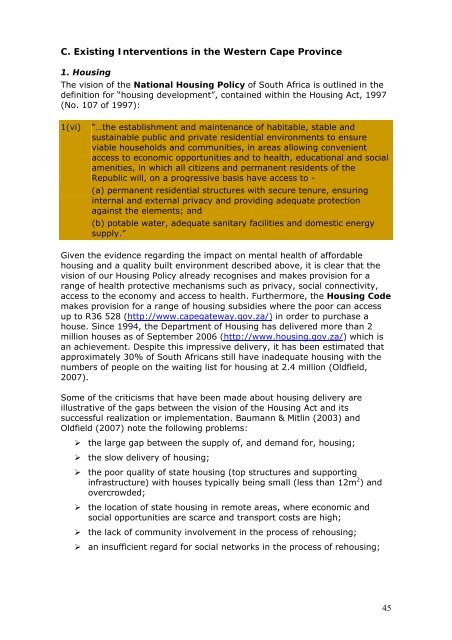(Volume 4) - Mental Health Disorders - Vula - University of Cape Town
(Volume 4) - Mental Health Disorders - Vula - University of Cape Town
(Volume 4) - Mental Health Disorders - Vula - University of Cape Town
Create successful ePaper yourself
Turn your PDF publications into a flip-book with our unique Google optimized e-Paper software.
C. Existing Interventions in the Western <strong>Cape</strong> Province1. HousingThe vision <strong>of</strong> the National Housing Policy <strong>of</strong> South Africa is outlined in thedefinition for “housing development”, contained within the Housing Act, 1997(No. 107 <strong>of</strong> 1997):1(vi)“…the establishment and maintenance <strong>of</strong> habitable, stable andsustainable public and private residential environments to ensureviable households and communities, in areas allowing convenientaccess to economic opportunities and to health, educational and socialamenities, in which all citizens and permanent residents <strong>of</strong> theRepublic will, on a progressive basis have access to -(a) permanent residential structures with secure tenure, ensuringinternal and external privacy and providing adequate protectionagainst the elements; and(b) potable water, adequate sanitary facilities and domestic energysupply.”Given the evidence regarding the impact on mental health <strong>of</strong> affordablehousing and a quality built environment described above, it is clear that thevision <strong>of</strong> our Housing Policy already recognises and makes provision for arange <strong>of</strong> health protective mechanisms such as privacy, social connectivity,access to the economy and access to health. Furthermore, the Housing Codemakes provision for a range <strong>of</strong> housing subsidies where the poor can accessup to R36 528 (http://www.capegateway.gov.za/) in order to purchase ahouse. Since 1994, the Department <strong>of</strong> Housing has delivered more than 2million houses as <strong>of</strong> September 2006 (http://www.housing.gov.za/) which isan achievement. Despite this impressive delivery, it has been estimated thatapproximately 30% <strong>of</strong> South Africans still have inadequate housing with thenumbers <strong>of</strong> people on the waiting list for housing at 2.4 million (Oldfield,2007).Some <strong>of</strong> the criticisms that have been made about housing delivery areillustrative <strong>of</strong> the gaps between the vision <strong>of</strong> the Housing Act and itssuccessful realization or implementation. Baumann & Mitlin (2003) andOldfield (2007) note the following problems:‣ the large gap between the supply <strong>of</strong>, and demand for, housing;‣ the slow delivery <strong>of</strong> housing;‣ the poor quality <strong>of</strong> state housing (top structures and supportinginfrastructure) with houses typically being small (less than 12m 2 ) andovercrowded;‣ the location <strong>of</strong> state housing in remote areas, where economic andsocial opportunities are scarce and transport costs are high;‣ the lack <strong>of</strong> community involvement in the process <strong>of</strong> rehousing;‣ an insufficient regard for social networks in the process <strong>of</strong> rehousing;45

















